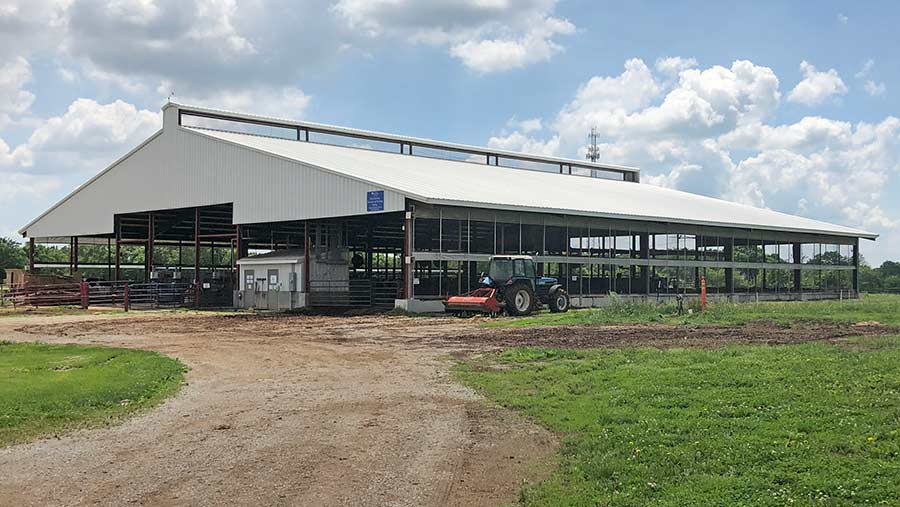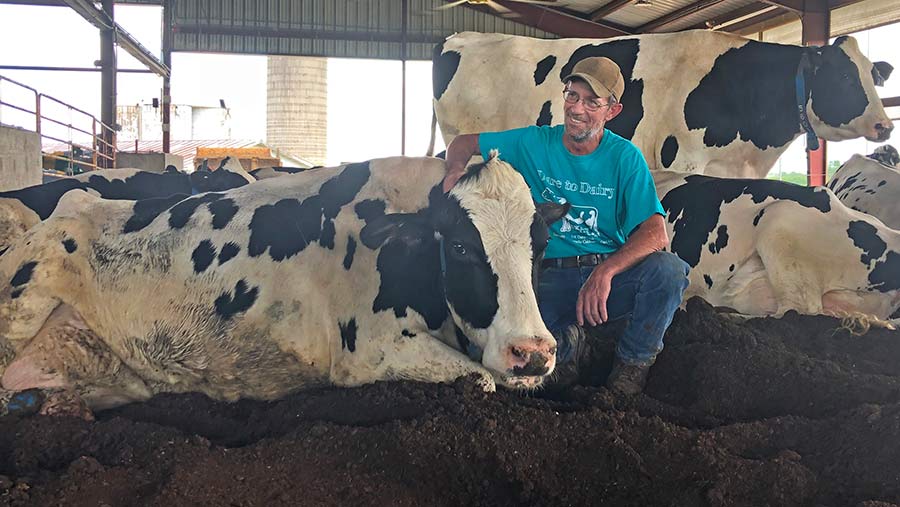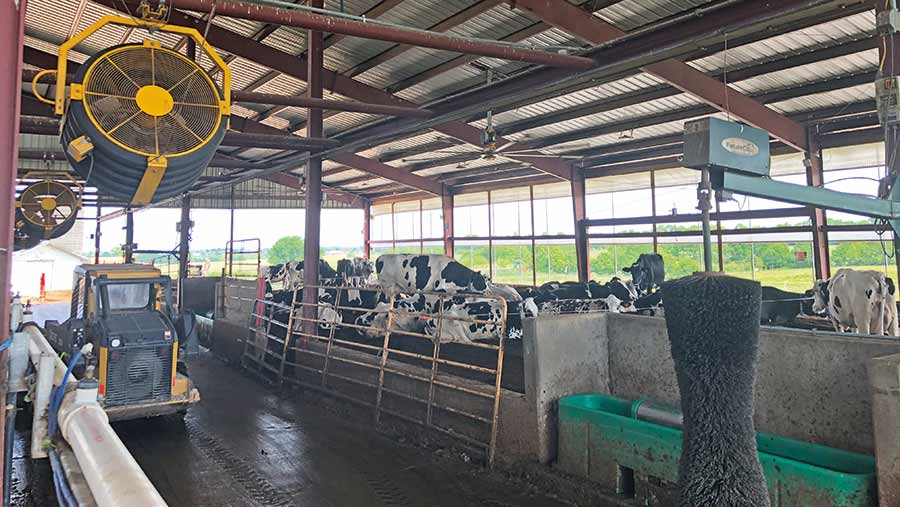What’s in your shed? visits a £550,000 Kentucky dairy shed

Set on the fringes of Lexington, the University of Kentucky’s Coldstream Dairy unit is a fount of research for dairy health efficiencies.
In the pursuit of cow comfort, the university erected a purpose-built shed in 2016. Housing 124 cows, the building is designed to optimise production and herd health.
Each of the 130 pedigree Holsteins is fitted with a number of recording devices which measure everything from temperature and activity to rumination.
See also: What’s In Your Livestock Shed: £5k sheep shed transformation
Herd manager Joey Clark has been at the centre of the new build and has seen the dramatic difference it has made.
Farm facts
- Cows milked twice daily
- The herd of 130 averages 11,566 litres a cow a year at 3.9% butterfat and 3% protein
- All-year-round calving
- About 121ha of crop and pasture
- Lactating cows kept indoors, and replacements and youngstock both grazed and indoors
- Lactating cow TMR is 55% forage/45% concentrates: corn silage, alfalfa, haylage, whole crop and processed feed mix to provide 25kg of dry matter per cow per day
How much did it cost and did it come in on budget?
The budget was £390,000 and we spent the entire budget.
There were additional costs associated with research-related items and part of those were donated or discounted. These costs would have been an additional £156,000.
We would like to have made further investments, including an automatic scraping system and a concreted walkway to the parlour.
What are the shed specifications?
The 150ft x 150ft (2,136sq m) shed is set up as loose housing, with two pens at either side of the barn that can be roped into three sections to divide up cows for management and research purposes.
It was designed for 124 cows, allowing for 100-110sq ft per cow.
A central lane allows tractor access to deliver feed, while two other alleys, floored with rubber matting, give the cows access to feed, water, sprinklers and cow brushes away from the bedded area. The surface means these can be scraped out easily.
The shed has an open ridge vent along the apex for ventilation and it has been positioned to catch the wind for natural ventilation.
The sides of the shed are open but have automatically adjustable curtains to protect the cows from the weather, with five temperature sensors around the barn.
What devices have you installed to improve cow comfort?
The barn has six Big Ass Powerfoil X3.0 fans installed overhead, which are integrated into the automatic temperature and humidity sensor system that monitors conditions for maximum cow comfort.
The three central alleys have overhead Yellow Jacket fans which work with a misting system to cool the cows. The new barn has helped quite a bit for us in terms of heat stress in the lactating cows.
The whole barn is lit with Big Ass Light Washdown LEDs, which are wet-rated fixtures that can be hosed off when they get dirty.
There are also six grooming brushes, three in each of the two cow alleys.
What did you have in mind when designing the shed?
Though cow comfort was a top priority, planning for the future meant location was also very important when designing the shed. We planned it so that when we build a new parlour, access will be easy.
Making sure the shed would work with research projects was also important. Not only can each pen be split into three, the alleys can be split via gates, with access to a water trough, feed and brushes in each section.

Joey Clark says the cows enjoy the green bedding, a mix of sawdust and cow manure
You’ve also installed green bedding. Tell us more.
The cows were moved into the shed on 21 April 2016, but before that they were in free stalls with either water mattresses or rubber cow mats. The unit is now using sawdust and cow manure for bedding.
One of the main reasons behind this was the high level of phosphorus on the university’s land, which means we cannot always apply slurry directly. Instead, we were paying someone to take it away. Now the composting binds the phosphorus and makes the manure more usable.
The bedding is tilled twice a day – taking about 25 minutes each side of the barn –to incorporate air and to keep moisture levels managed, with a target of 50-55% dry matter.
In the winter we have to be more diligent about keeping the moisture level down. Though this takes around the same time as the previous system with free stalls, which had to be hand-raked to redistribute the sawdust, the work can now be done on a tractor.
There’s no smell from the bedding and even when temperatures are just above freezing, it continues to compost, which is all down to the ventilation of the barn.

Ventilation was a key consideration in both the positioning and design of the shed
What difference has the shed made?
As well as drastically improving cow comfort, moving to the new shed has boosted milk production.
We were averaging 32-33 litres a cow a day, but now it’s around 36 litres. And we’re no longer getting a drastic drop in production during the summer months. In our old shed we would lose 3.6-4.5 litres a day.
The increase in yield is also helped by better access to feed, which is pushed up to the central feeding alley by a robot. The sprinklers also encourage the cows to eat more on a hot day.
On top of this, the somatic cell count (SCC) has more than halved, from 250,000-300,000 cells/ml to about 110,000, meaning the unit now gets a quality bonus on its milk cheque.
In addition, there have been no hock abrasions over the past two summers and although hoof growth hasn’t altered, we have seen a big reduction in digital dermatitis.
What’s your favourite feature?
The cows love the shed, especially the green bedding. If I come out at night, they are all lying down. The cows are easier to manage, and it was definitely a worthwhile investment.
